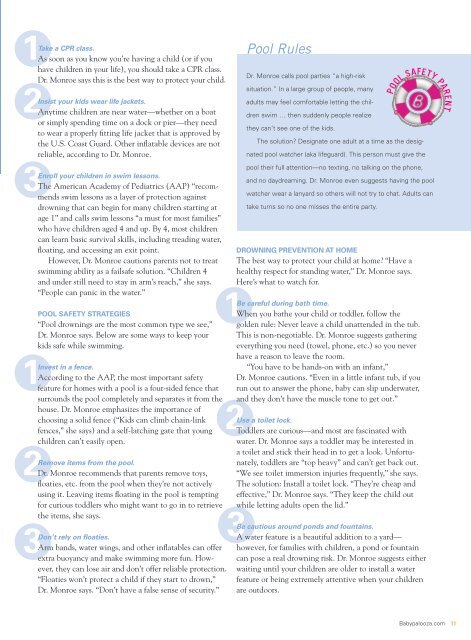Babypalooza Summer 2019
Create successful ePaper yourself
Turn your PDF publications into a flip-book with our unique Google optimized e-Paper software.
1Take a CPR class.<br />
As soon as you know you’re having a child (or if you<br />
have children in your life), you should take a CPR class.<br />
Dr. Monroe says this is the best way to protect your child.<br />
2<br />
Insist your kids wear life jackets.<br />
Anytime children are near water—whether on a boat<br />
or simply spending time on a dock or pier—they need<br />
to wear a properly fitting life jacket that is approved by<br />
the U.S. Coast Guard. Other inflatable devices are not<br />
reliable, according to Dr. Monroe.<br />
3Enroll your children in swim lessons.<br />
The American Academy of Pediatrics (AAP) “recommends<br />
swim lessons as a layer of protection against<br />
drowning that can begin for many children starting at<br />
age 1” and calls swim lessons “a must for most families”<br />
who have children aged 4 and up. By 4, most children<br />
can learn basic survival skills, including treading water,<br />
floating, and accessing an exit point.<br />
However, Dr. Monroe cautions parents not to treat<br />
swimming ability as a failsafe solution. “Children 4<br />
and under still need to stay in arm’s reach,” she says.<br />
“People can panic in the water.”<br />
1<br />
POOL SAFETY STRATEGIES<br />
“Pool drownings are the most common type we see,”<br />
Dr. Monroe says. Below are some ways to keep your<br />
kids safe while swimming.<br />
1Invest in a fence.<br />
According to the AAP, the most important safety<br />
feature for homes with a pool is a four-sided fence that<br />
surrounds the pool completely and separates it from the<br />
house. Dr. Monroe emphasizes the importance of<br />
2<br />
choosing a solid fence (“Kids can climb chain-link<br />
fences,” she says) and a self-latching gate that young<br />
children can’t easily open.<br />
2<br />
Remove items from the pool.<br />
Dr. Monroe recommends that parents remove toys,<br />
floaties, etc. from the pool when they’re not actively<br />
using it. Leaving items floating in the pool is tempting<br />
for curious toddlers who might want to go in to retrieve<br />
the items, she says.<br />
3<br />
3Don’t rely on floaties.<br />
Arm bands, water wings, and other inflatables can offer<br />
extra buoyancy and make swimming more fun. However,<br />
they can lose air and don’t offer reliable protection.<br />
“Floaties won’t protect a child if they start to drown,”<br />
Dr. Monroe says. “Don’t have a false sense of security.”<br />
Pool Rules<br />
Dr. Monroe calls pool parties “a high-risk<br />
situation.” In a large group of people, many<br />
adults may feel comfortable letting the children<br />
swim … then suddenly people realize<br />
they can’t see one of the kids.<br />
The solution? Designate one adult at a time as the designated<br />
pool watcher (aka lifeguard). This person must give the<br />
pool their full attention—no texting, no talking on the phone,<br />
and no daydreaming. Dr. Monroe even suggests having the pool<br />
watcher wear a lanyard so others will not try to chat. Adults can<br />
take turns so no one misses the entire party.<br />
DROWNING PREVENTION AT HOME<br />
The best way to protect your child at home? “Have a<br />
healthy respect for standing water,” Dr. Monroe says.<br />
Here’s what to watch for.<br />
POOL SAFETY PARENT<br />
Be careful during bath time.<br />
When you bathe your child or toddler, follow the<br />
golden rule: Never leave a child unattended in the tub.<br />
This is non-negotiable. Dr. Monroe suggests gathering<br />
everything you need (towel, phone, etc.) so you never<br />
have a reason to leave the room.<br />
“You have to be hands-on with an infant,”<br />
Dr. Monroe cautions. “Even in a little infant tub, if you<br />
run out to answer the phone, baby can slip underwater,<br />
and they don’t have the muscle tone to get out.”<br />
Use a toilet lock.<br />
Toddlers are curious—and most are fascinated with<br />
water. Dr. Monroe says a toddler may be interested in<br />
a toilet and stick their head in to get a look. Unfortunately,<br />
toddlers are “top heavy” and can’t get back out.<br />
“We see toilet immersion injuries frequently,” she says.<br />
The solution: Install a toilet lock. “They’re cheap and<br />
effective,” Dr. Monroe says. “They keep the child out<br />
while letting adults open the lid.”<br />
Be cautious around ponds and fountains.<br />
A water feature is a beautiful addition to a yard—<br />
however, for families with children, a pond or fountain<br />
can pose a real drowning risk. Dr. Monroe suggests either<br />
waiting until your children are older to install a water<br />
feature or being extremely attentive when your children<br />
are outdoors.<br />
<strong>Babypalooza</strong>.com 11









